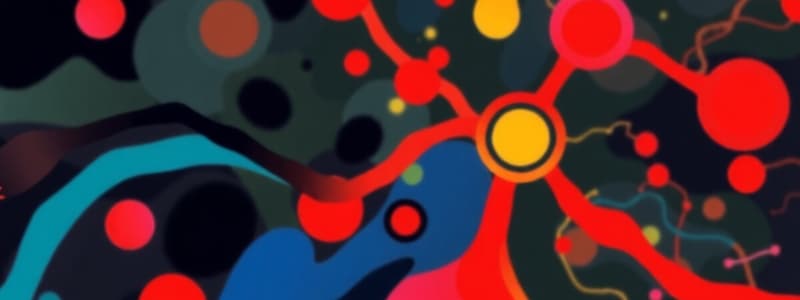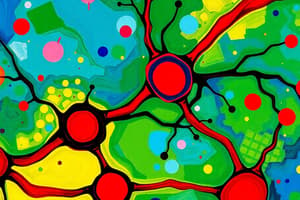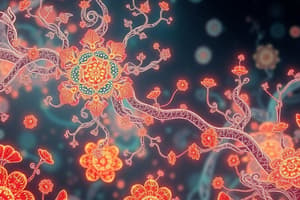Podcast
Questions and Answers
What is the primary mechanism by which RTK signaling is terminated?
What is the primary mechanism by which RTK signaling is terminated?
- Internalization (receptor endocytosis and degradation) (correct)
- Upregulation (receptor synthesis and delivery)
- Phosphorylation of RTKs
- Binding of agonist ligands
Which of the following is a characteristic of Receptor Tyrosine Kinases (RTKs)?
Which of the following is a characteristic of Receptor Tyrosine Kinases (RTKs)?
- They directly generate intracellular cAMP.
- They have intrinsic protein kinase activity. (correct)
- They activate G proteins to initiate a signaling cascade.
- They primarily bind to hydrophobic ligands.
Which of the following is NOT a typical mechanism by which target cells become desensitized to a signal molecule?
Which of the following is NOT a typical mechanism by which target cells become desensitized to a signal molecule?
- Inactivation of signaling protein
- Increased receptor production (correct)
- Receptor downregulation
- Receptor sequestration
What is the function of autophosphorylation in receptor tyrosine kinases (RTKs)?
What is the function of autophosphorylation in receptor tyrosine kinases (RTKs)?
What distinguishes receptor tyrosine kinases (RTKs) from G protein-coupled receptors (GPCRs) in signal transduction?
What distinguishes receptor tyrosine kinases (RTKs) from G protein-coupled receptors (GPCRs) in signal transduction?
Which of the following is a characteristic of ionotropic receptors?
Which of the following is a characteristic of ionotropic receptors?
What is the primary function of ionotropic receptors?
What is the primary function of ionotropic receptors?
What is the direct result of ligand binding to ionotropic receptors?
What is the direct result of ligand binding to ionotropic receptors?
Which characteristic is associated with ionotropic receptors?
Which characteristic is associated with ionotropic receptors?
What is the role of the neuromuscular junction?
What is the role of the neuromuscular junction?
How does the binding of acetylcholine (ACh) to its receptor at the neuromuscular junction initiate muscle contraction?
How does the binding of acetylcholine (ACh) to its receptor at the neuromuscular junction initiate muscle contraction?
What is the function of intracellular receptors?
What is the function of intracellular receptors?
How do intracellular receptors access their ligands?
How do intracellular receptors access their ligands?
Which of the following ligands is most likely to interact with an intracellular receptor?
Which of the following ligands is most likely to interact with an intracellular receptor?
What is the result of ligand binding to intracellular receptors?
What is the result of ligand binding to intracellular receptors?
How does the location of intracellular receptors affect their function?
How does the location of intracellular receptors affect their function?
Which type of receptor has the fastest cellular response?
Which type of receptor has the fastest cellular response?
Which of the following receptor types is known for producing the slowest cellular responses?
Which of the following receptor types is known for producing the slowest cellular responses?
How does the mechanism of receptor-mediated endocytosis begin?
How does the mechanism of receptor-mediated endocytosis begin?
How is cholesterol transported into cells via receptor-mediated endocytosis?
How is cholesterol transported into cells via receptor-mediated endocytosis?
Which of the following molecules is essential for receptor-mediated endocytosis?
Which of the following molecules is essential for receptor-mediated endocytosis?
What event immediately follows the formation of a coated vesicle during receptor-mediated endocytosis?
What event immediately follows the formation of a coated vesicle during receptor-mediated endocytosis?
What happens to LDL receptors after endocytosis has occurred?
What happens to LDL receptors after endocytosis has occurred?
Which of the following statements best describes the function of a kinase?
Which of the following statements best describes the function of a kinase?
What is the typical outcome of protein phosphorylation?
What is the typical outcome of protein phosphorylation?
Where on the membrane are the ligand-binding domain and enzyme active site located on Receptor Tyrosine Kinases
Where on the membrane are the ligand-binding domain and enzyme active site located on Receptor Tyrosine Kinases
Which of the following receptors has the fastest response time?
Which of the following receptors has the fastest response time?
Which of the following is an example of a receptor tyrosine kinase (RTK)?
Which of the following is an example of a receptor tyrosine kinase (RTK)?
What is the role of autophosphorylation of tyrosine residues in Receptor Tyrosine Kinases?
What is the role of autophosphorylation of tyrosine residues in Receptor Tyrosine Kinases?
Which of the following is a key characteristic of hormones that bind to intracellular receptors?
Which of the following is a key characteristic of hormones that bind to intracellular receptors?
How do intracellular receptors influence cellular activity after binding to their ligand?
How do intracellular receptors influence cellular activity after binding to their ligand?
What is a consequence of mutations that constitutively activate receptor tyrosine kinases (RTKs)?
What is a consequence of mutations that constitutively activate receptor tyrosine kinases (RTKs)?
Which ion is most closely associated with the function of the GABA-A receptor?
Which ion is most closely associated with the function of the GABA-A receptor?
What is the outcome of the influx of chloride ions through the GABA-A receptor?
What is the outcome of the influx of chloride ions through the GABA-A receptor?
Which type of receptor activation is most closely associated with memory and learning processes?
Which type of receptor activation is most closely associated with memory and learning processes?
What is the role of the protein, Clathrin, in receptor-mediated endocytosis?
What is the role of the protein, Clathrin, in receptor-mediated endocytosis?
In the context of receptor-mediated endocytosis, what is the fate of a vesicle after it loses its Clathrin coat?
In the context of receptor-mediated endocytosis, what is the fate of a vesicle after it loses its Clathrin coat?
Consider a mutation that prevents the autophosphorylation of a receptor tyrosine kinase (RTK). What is the most likely downstream effect?
Consider a mutation that prevents the autophosphorylation of a receptor tyrosine kinase (RTK). What is the most likely downstream effect?
A researcher is studying a new signaling pathway and observes that ligand binding to a receptor leads to a rapid increase in intracellular calcium. This effect is blocked by a drug that inhibits cAMP production. Which type of receptor is most likely involved?
A researcher is studying a new signaling pathway and observes that ligand binding to a receptor leads to a rapid increase in intracellular calcium. This effect is blocked by a drug that inhibits cAMP production. Which type of receptor is most likely involved?
Flashcards
Receptor Tyrosine Kinase (RTK)
Receptor Tyrosine Kinase (RTK)
RTKs are membrane receptors with intrinsic protein kinase activity that transduce extracellular signals.
RTK Structure
RTK Structure
The receptor's ligand-binding region is on the extracellular face, while the active site is on the cytoplasmic face.
Kinase Function
Kinase Function
Kinases catalyze the addition of phosphate groups to proteins.
Termination of RTK signal
Termination of RTK signal
Signup and view all the flashcards
Ionotropic Receptors
Ionotropic Receptors
Signup and view all the flashcards
Excitability and Ion Channels
Excitability and Ion Channels
Signup and view all the flashcards
Ligand Binding
Ligand Binding
Signup and view all the flashcards
Neuromuscular Junction
Neuromuscular Junction
Signup and view all the flashcards
Intracellular Receptors
Intracellular Receptors
Signup and view all the flashcards
Receptor Location
Receptor Location
Signup and view all the flashcards
Ligand Function
Ligand Function
Signup and view all the flashcards
Receptor Mediated Endocytosis
Receptor Mediated Endocytosis
Signup and view all the flashcards
Clathrin
Clathrin
Signup and view all the flashcards
Receptor Activation
Receptor Activation
Signup and view all the flashcards
GABA-A Receptor
GABA-A Receptor
Signup and view all the flashcards
Study Notes
Cellular Communication 4
- Focuses on Receptor Tyrosine Kinases (RTKs), ionotropic receptors, intracellular receptors, correlating receptor mechanisms with cellular response speed, and receptor-mediated endocytosis.
Major Types of Receptors and Signal Transducers
- G protein-coupled receptors activate an intracellular GTP-binding protein (G), regulating an enzyme (Enz) to produce an intracellular second messenger (X).
- Receptor tyrosine kinases activate tyrosine kinase activity by autophosphorylation upon ligand binding.
- Receptor guanylyl cyclase stimulates the formation of cyclic GMP, a second messenger, when a ligand binds to its extracellular domain.
- Adhesion receptors (integrins) bind molecules in the extracellular matrix, changing conformation and interaction with the cytoskeleton.
- Gated ion channels open or close in response to a signal ligand concentration or membrane potential.
- Nuclear receptors allow steroid binding to regulate specific gene expression.
Kinases and Phosphorylation
- Kinases are enzymes catalyzing protein phosphorylation with ATP.
- Phosphorylation usually changes the target protein's function by altering enzyme activity, cellular location, or association with other proteins.
- Phosphorylation can occur by autophosphorylation or by binding to activator/inhibitor proteins.
- Phosphorylation of proteins regulate several cellular pathways.
Protein Kinase Receptors
- Two main types of protein kinase receptors exist.
- One type is Serine/Threonine Kinases, which phosphorylates serine and threonine amino acids and includes MAP kinase, involved in mitoses and cellular differentiation.
- The other type is Tyrosine Kinases, which phosphorylates proteins on tyrosine amino acid residues and includes insulin and growth factor receptors.
Receptor Tyrosine Kinase (RTK)
- RTKs are membrane receptors with intrinsic protein kinase activity, using autophosphorylation.
- RTKs transduce extracellular signals differently than GPCRs.
- RTKs include an extracellular ligand-binding domain and a cytoplasmic face with an enzyme active site, connected by a single transmembrane segment.
- The cytoplasmic domain is a protein kinase that phosphorylates TYR residues.
- Examples of RTKs are receptors for insulin and epidermal growth factors.
Receptor Tyrosine Kinase Example
- Here is an example using an Insulin Receptor:
- Signal molecules bind to receptor tyrosine kinase proteins (inactive monomers)
- This causes dimerization
- The receptors phosphorylate each other
- This attracts the active relay proteins which activate cellular responses
Termination of RTK Signal
- Downregulation is the major regulatory mechanism for RTK signal termination through receptor endocytosis and degradation.
- Receptors and signals can also be terminated by sequestration, inactivation, inhibitory proteins or modulation
- The receptor can also be regulated via phosphorylation state modulation
- Antagonist ligands can inhibit the biological responses mediated by the receptor.
Ionotropic Receptors (Ligand-Gated Ion Channels)
- Electrically excitable cells use ionotropic receptors to convert external signals into electrical signals by changing the membrane potential.
- These receptors are central in nerve conduction, muscle contraction, hormone secretion, and sensory and learning processes.
- Excitability relies on channels and type of ion they pass.
- The channels are signal transducers that regulate inorganic ion movement across the plasma membrane in response to stimuli.
- Channels are gated and activated by binding specific ligands/first messengers like neurotransmitters or hormones.
Ionotropic Receptors Examples
- GABA-A receptors can pass Cl- or HCO3- and are the major inhibitory neurotransmitter in the CNS.
- Nicotinic Acetylcholine receptors can pass Na+, K+, and Ca+2 and typically mediate excitatory neurotransmission.
Nicotinic Acetylcholine (ACh) Receptor
- Nicotinic acetylcholine (ACh) receptor is found at the neuromuscular junction.
- The neuromuscular junction is a synapse between a motor neuron and a muscle fiber.
- The signal causes membrane depolarization, triggering skeletal muscle contraction.
Intracellular Receptors
- Lipophilic ligands utilize intracellular receptors These ligands are carried by transport proteins in the blood plasma and then dissociate to enter target cells
- Small hydrophobic signal molecules diffuse directly across the plasma membrane into the target cells.
- Intracellular receptors (in the cytoplasm OR in the nucleus) act as transcription regulators.
- Examples of these lipophilic ligands includes steroid hormones, thyroid hormones, retinoids, and vitamin D.
Intracellular Receptors ARE Receptors and Effectors of the Ligands
- Ligands bind to their intracellular receptor proteins, altering the ability of these proteins to control the transcription of specific genes.
Speed of Cellular Response
- Ligand-gated ion channels' response time is in milliseconds such as Cholinergic nicotinic receptors
- G protein-coupled receptors' response time is in seconds such as a and ẞ adrenoceptors, and muscarinic cholinergic receptors.
- Enzyme-linked receptors' response time is in minutes such as insulin and cytokine receptors.
- Intracellular receptors' response time is in minutes to hours such as steroid receptors.
Receptor Mediated Endocytosis
- Initiated when receptors are activated by the signal
- Membrane associated protein CLATHRIN is essential for this mechanism
Endocytosis of cholesterol via LDL: An Example:
- A molecule binds to a protein receptor
- This leads to the molecules moving to a clathrin coated pit
- The pit and cell membrane start to fold inwards
- This forms a coated vesicle
- The vesicle fuses with an endosome
- The receptors and molecules separate.
Studying That Suits You
Use AI to generate personalized quizzes and flashcards to suit your learning preferences.



